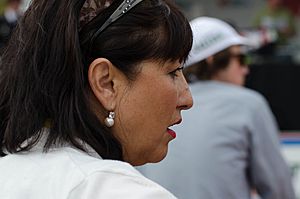Pearl Calahasen facts for kids
Quick facts for kids
The Honourable
Pearl Calahasen
|
|
|---|---|
 |
|
| Member of the Legislative Assembly of Alberta for Lesser Slave Lake | |
| In office 20 March 1989 – 5 May 2015 |
|
| Preceded by | Larry Shaben |
| Succeeded by | Danielle Larivee |
| Alberta Minister of Aboriginal Affairs and Northern Development | |
| In office 15 March 2001 – 15 December 2006 |
|
| Preceded by | Ministry Established |
| Succeeded by | Guy Boutilier |
| Alberta Associate Minister of Aboriginal Affairs | |
| In office 26 May 1999 – 15 March 2001 |
|
| Succeeded by | Ministry Abolished |
| Alberta Minister without Portfolio in charge of Children's Services | |
| In office 31 May 1996 – 26 May 1999 |
|
| Succeeded by | Iris Evans |
| Personal details | |
| Born | 5 December 1952 Grouard, Alberta |
| Political party | Progressive Conservative |
| Alma mater | University of Alberta University of Oregon |
Pearl Calahasen is a Canadian politician. She was a member of the Legislative Assembly of Alberta from 1989 to 2015. She represented the area called Lesser Slave Lake.
Pearl Calahasen was part of the Progressive Conservative party. She also served as a minister in the government. She held important roles like Minister in charge of Children's Services and Minister of Aboriginal Affairs.
She made history as the first Métis woman to be elected to public office in Alberta. After the 2012 Alberta election, she was the longest-serving Member of the Legislative Assembly (MLA) in Alberta at that time.
Contents
Early Life and Education
Pearl Calahasen was born in 1952. She grew up in Grouard, Alberta. She went to the University of Alberta and earned a degree in Education.
She also studied at the University of Oregon, where she received a master's degree. Pearl Calahasen is a member of the Métis Nation of Alberta.
Political Career Highlights
Becoming an MLA
Pearl Calahasen first ran for election in 1989. She was a candidate for the Progressive Conservative party in the Lesser Slave Lake area. She won the election with 47.6% of the votes.
This was her closest election win. In later elections, she won by much larger margins. For example, in 2001, she won with 74.2% of the votes. When she was elected in 1989, she became the first Métis woman to hold public office in Alberta.
Roles in Government
Pearl Calahasen served as a regular member of the legislature until 1996. Then, she was appointed as a minister. Her first role was Minister without Portfolio, responsible for Children's Services.
In 1999, she became the Associate Minister of Aboriginal Affairs. By 2001, she was promoted to the full Minister of Aboriginal Affairs and Northern Development. She held this position until 2006.
New Laws and Initiatives
Pearl Calahasen helped create several new laws during her time in the legislature.
Laws as a Regular Member
In 1990, even before she became a minister, she supported the Metis Settlements Act. This law helped Métis settlements become a new type of municipality. It was supported by other political parties too.
She also supported the Public Health Amendment Act in 1995. This law allowed nurse practitioners to do some of the work of doctors in areas where doctors were scarce. This helped more people get healthcare.
Laws as a Minister
As the Associate Minister of Aboriginal Affairs, Pearl Calahasen sponsored the First Nations Sacred Ceremonial Objects Repatriation Act in 2000. This important law allowed First Nations artifacts to be returned to their communities. This bill also received full support from other parties.
In 2012, Pearl Calahasen became the longest-serving MLA in Alberta's history. She held this record for a time, showing her long dedication to public service.
Images for kids


